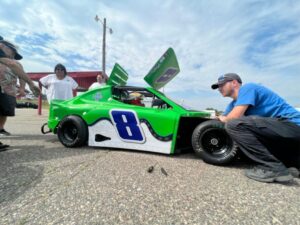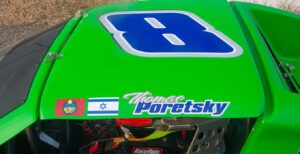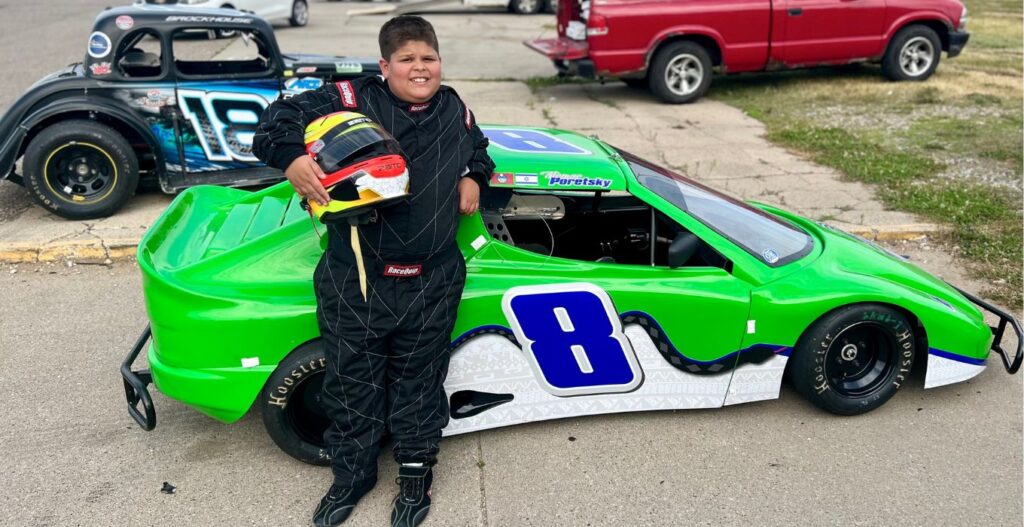ELKO NEW MARKET, Minn. – Thomas Poretsky is six years away from being behind the wheel of a street-legal car and is too young to drive bumper cars at the State Fair. This is ironic as he stands in the shadow of Elko Speedway in a firesuit and holding his racing helmet, waiting to take his Bandolero race car onto the track to get some practice laps in.
“I don’t like bumper cars,” he said. “I’m trying to avoid running into things.”
Thomas, a 10-year-old Prior Lake resident, has been driving cars for nearly half of his life. His no. 8 car is emblazoned with two important pieces of family heritage, an Israeli flag denoting his father’s Jewish heritage, and a flag of the Quechan Nation, his Native American tribe of his mother’s side of the family.
“It means a lot to me,” Thomas said last week in between practice sessions, “There’s not a lot of Native and Jewish mixes and it’s just … me. It shows my story.”
Thomas is in his first season driving Bandoleros but has been behind the wheel of cars since he was six.
“Thomas was always shy; it’s his brother, William, that is very outgoing and made friends easily,” said Mary Poretsky, Thomas’ mother. “Thomas was always quiet and shy and not sure of himself. And one day, he said, he said he wanted to race cars.
“He and I, we made this deal. he said, ‘Mom, I’ll race as long as you’re there.’ So I said, Okay. And then one thing led to another and then I’m looking for a car.”
Thomas started driving where so many young drivers – including professionals – started: quarter-midget cars. They learned that those cars require more maintenance than the Bandoleros, so they made the move up a class.
The Bandolero looks like a scaled-down stock car. It has a tube frame with a roll cage to protect the driver and is covered by fiberglass panels that can be removed for maintenance. The cars all have the same 30-horsepower Briggs and Stratton motor. The cars all race at the same weight even factoring the driver; weight is added where needed. The only difference is the color and the person behind the wheel.
“It’s an introductory class for kids,” said Tim Brockhouse, the owner of Burnsville’s Great North Legends, who maintains Thomas’ car. “And that’s what we try to keep it as. They actually have adults racing them down south, but at 14 we kick them out.”
Thomas drives his car around the ¼ mile inner oval at Elko Speedway at roughly 46 miles per hour. His father Solomon times his laps and said Thomas was consistently between 18.9 and 19.1 seconds per lap.
“I’m really, really happy with his performance,” he said. “If you rip a good lap, the problem is you may not be able to repeat it. If you’re consistent, you always do the same thing.”
Consistency has been a feature of Thomas’ racing. He took part in a competitive go-kart league at Pro Kart in Burnsville last winter. Solomon Poretsky said that he was never near the front of the pack, but consistent laps and finishes helped him to third place in the final standings, behind “generational racing families.”
“For a starting Bando racer to finish every race and not damage your car, that’s an accomplishment,” he said. “His car control’s pretty good, especially for beginning driver.”
Family affair
Solomon and Mary Poretsky met online in the pre-dating app era, after he answered an ad she placed on Yahoo! Personals.
“He sent me this whole dissertation,” she said.
“It was more of a thesis,” he quipped back.
That was 25 years ago, and 17 years ago when they moved to Minnesota from Sacramento, Solomon knew that they didn’t want their kids to play hockey. It was too expensive, he said, laughing.

Tim Brockhouse (left) oversees the repair of Thomas Poretsky’s car before practice laps at Elko Speedway. (Photo by Lonny Goldsmith/TC Jewfolk)
Thomas’ car cost $7,000, and the engine, because it is sealed, can only be purchased from one spot, and can’t be tampered with, is $2,500.
“There’s this perception of racing, and the reality here is so opposite from the perception,” Solomon said.
Mary talked about how in an early practice session, his engine blew out and he had to be pushed up the track.
“[Thomas] was in tears,” she said. “And people just came to help, and slap a new engine in. Nobody asked for anything. I was saying thank you to everybody, and everybody kept saying ‘It’s for the kids.’”
None of the Poretskys are mechanically inclined. Filling up the engine with gas and checking the tire pressure is easy, but replacing an engine or reconnecting a loose chain to the drivetrain, which happened at last week’s practice, requires the assistance of others.
“Nobody looks at us weird or anything. Unless you get in the way when they’re trying to do things,” Mary said. “Its been a really good experience for us, I think, as a family.”
Since he’s started racing at his current level, his parents and their friends have noticed a different kid.
“He walks differently, he talks with a little bit more authority,” Mary said. “It’s like he came out of his shell. He’s making friends left and right. He has the admiration of the kid in his class. His teacher even came at the end of school to watch him.”
Said Thomas: “[My friends] didn’t believe it until I showed them a picture of the car.”
Meaning in the car design
Solomon and Thomas both said a plain, white car was fine. Mary protested.
“No, it needs to be pretty,” she said.

The roof of Thomas Poretsky’s car, featuring the Quechan and Israeli flags. (Photo courtesy of the Poretsky family)
The car number is for Thomas’ favorite NASCAR driver, Kyle Busch. The white on the bottom features tribal-inspired geometric patterns, the white and green are separated with a thin line of blue, with a diamondback snake over it. The snake is native to the southwest where Mary’s tribe originates.
The flags on either side of his name over the windows to the car was the icing on the cake.
“He’s Native American. And he’s Jewish. And we should be proud of that. And we should be proud of him,” said Mary. She pointed out a key commonality between the Quechan area and Israel. “I know the climate there is desert. And for us, we’re in the southwest. So it’s, it’s about as desert as you can get.”
Said Solomon. “Hers is a Colorado River tribe so it’s very similar to Jordan and the in the Galilee in our history. It’s a desert people with water.”
Towards the rear of the car behind the windows on each side is a blue Thunderbird. In Native traditions, the Thunderbird is a desert bird that is the protector of the sky.
“When he flaps his wings, that’s the thunder. And he shoots lightning out of his eyes,” Mary said. “I thought that was good for Thomas to have a protector.”
Thomas said he drives for two reasons: Just to do it, and because he gets to inspire people.
“That’s a really big thing for me,” he said. “A lot of people wish they could do this, and it’s just cool to know that they’re feeling happy because they’re inspired to follow their dreams.”





This is so exciting to me because I am one half of a Jewish Native American family, and I didn’t think there was anyone out there like us! My son is half Jewish and half Lakota/Arikara and LOVES race cars. Where can we come see you race?
That’s SO COOL! My mind is blown! He races at Elko Speedway, which is south of the Cities on I-35, and the next couple of races are July 22 and August 5 (there’s a chance he’ll miss August 5). Gates open at 4:30, the first bando feature is usually right around 5pm, and please come into the Bando pits (they’re open) and meet us and see the car up close. Feel free to search “Thunderbird Racing” at Facebook (hopefully, it’s linked here), and Elko Speedway’s URL is just their name. See you soon!
Great! We’ll see if we can make it on the 22nd!